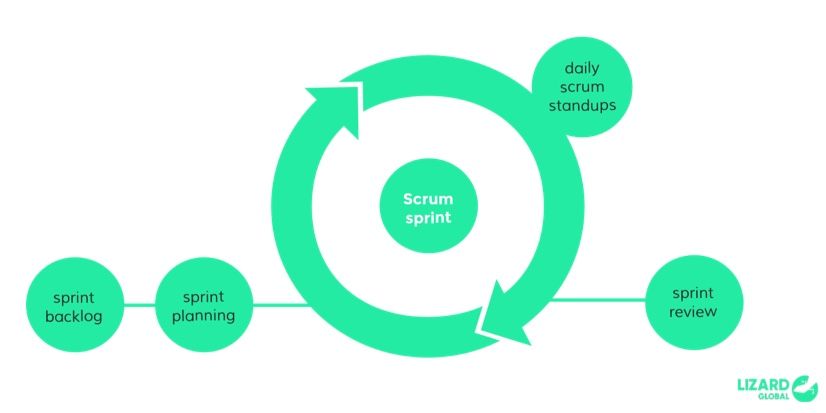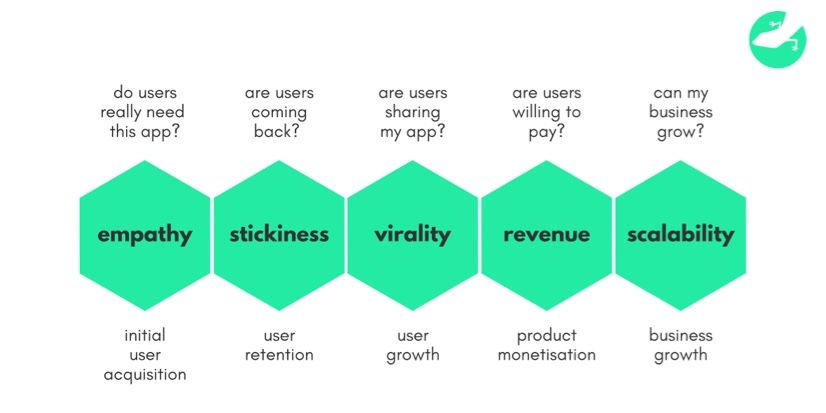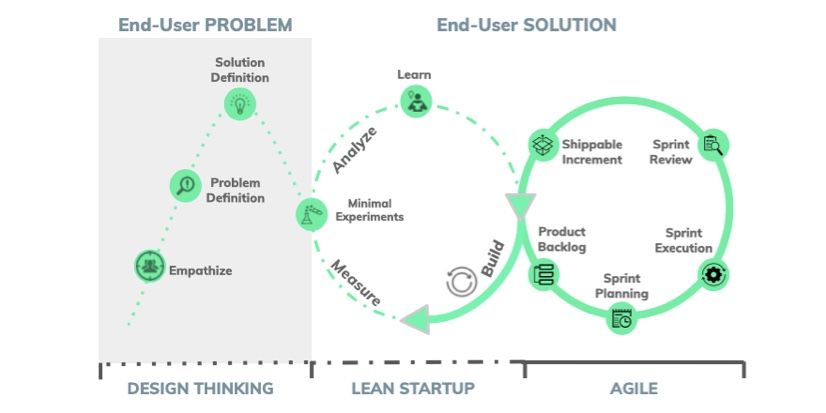How to Combine Design Thinking & Agile Solution for Maximum Efficiency
Get the latest updates about our blog posts.
Subscribe so you don’t miss out!
Follow Lizard Global on Facebook, Instagram, and LinkedIn.
Agile, Lean, and Scrum: you might have heard about these terms before, especially if you’re working in a startup or scaleup environment. Implementing Agile and Lean ways of working and using Scrum methodologies is becoming increasingly popular among modern businesses that are looking for a way to improve the efficiency of their internal production processes. The iterative operations on which these terms are based are developed in order to provide clients and end-users with the best possible solutions, in the most efficient, sustainable, and cost-effective way. These aren’t just buzzwords; they’re critical for the success of modern software development, and there’s much more to it than the basic concept of testing, reviewing, and adjusting.
What is Agile, Lean, Scrum, and Design Thinking?
Before we go deeper into the benefits of Agile methodologies, like Scrum Sprints and Lean Analytics, it’s good to have a clear idea of what these terms stand for.
What is Agile and how it works?
The definition of Agile is based on the iterative process of creating, testing, reviewing, and adjusting in order to make sure the end user receives the perfect end solution. This loop of feedback and adaptation is essential for app developers to create a better understanding of what the end user wants, and how they visualize their ideal end-product.
Working Agile has its focuses on the efficient interaction between team members and their individual tasks and tools. The term “Agile” comes from the concept of agility, which is defined as the ability to move and think quickly, easily, and flexibly. An Agile working method revolves around a constant awareness of change, in order to continuously comply with the customer’s needs. All processes within Agile product management are organized in such a way that there’s always a possibility to adjust specific elements without having to spend too much time and effort in implementing these changes.
Agile is the ability to deliver user-focused solutions in an iterative manner so that there is end-user-tangible product improvement with each sprint. One key to Agile is that each sprint provides a clear testable product piece or addition.
Agile Scrum Methodologies
At Lizard Global, we work with Scrum sprints, which are short, usually bi-weekly, cycles focused on developing a product in the most Agile, cost-effective, and efficient way possible. Due to its iterative nature, a Scrum sprint allows users to evaluate the product they’re working on after every incremental delivery. By providing the constant possibility to validate decisions and implementations with the end-users, the Scrum team can ensure that the product, including its functionalities and graphic elements, are always aligned with the needs of the user and establish a perfect product-market-fit.
The main focus of the process of a Scrum sprint is based on velocity. Every idea, step, and action has to be planned, prioritized, and performed in such a way it reaches a maximum level of speed, efficiency, and productivity. After all, a lot of work has to be done in a very short period of time. Any minor mistake or overlooked issue can cause problematic congestion further on in the process. A typical project based on Scrum methodology consists of five cyclical phases:
A Scrum approach starts off with the responsible team clearly assembling and defining the project.
So-called Product Backlogs are produced to contextualize everything that needs to happen in order to create the product in the form of, for example, the specification of technical features or the creation of user stories.
After all the product requirements are defined, it’s time for Sprint Planning, facilitated by the Scrum Master. In this phase, the Product Owner defines the details of the Product Backlog, and the Agile development team defines and decides about the required time for the project and a division of task among the team members.
Daily Scrum meetings are meant to keep in check if everyone is up-to-date with their tasks and if there are any bottlenecks standing in the way of achieving the deadline.
Every Sprint ends with a so-called Sprint Review or Retrospective, in which the team looks back at what was done, how it was done, and if there’s a need for adjustments and improvements in the Product Backlog. We also use this opportunity to plan the next sprint, so the cycle keeps going on.

At Lizard Global, we’ve fully implemented Agile ways of working in our business processes. All our development processes are built upon strict bi-weekly Scrum sprints, in which all Scrum team members are continuously focused on the tasks at hand. Our Agile ways of working aren’t just being implemented in our app development processes, but all other processes as well. We work with (bi-)weekly meetings to check in on all our departments and continuously analyze what can be improved.
What is the Lean Startup method?
The definition of Lean Startup was coined by Eric Ries in his book “The Lean Startup” back in 2011, in which he explains the term as the Agile approach for structuring business processes and continuously adapting strategies where needed. The Lean Startup approach focuses on eliminating all internal production processes and decisions that don’t add value to the end product and the customer. This way, the process of app development can be simplified and turned into 100% Agile. Bringing value to the customer is the main goal of the Lean Startup ideology, and getting rid of all the procedures that don’t contribute to this value can save a lot of time, effort, and money in the end.
Lean Analytics
The Lean Startup approach forms one of the cornerstones of our business processes within Lizard Global. Following the mindset of the Lean Startup, we implement so-called Lean Analytics in our business processes. ‘Lean Analytics’ is a term coined by Benjamin Yoskovitz and Alistair Croll in their book of the same name, and can be defined as an extension of the Lean Startup approach. It is used to measure the growth of a business by analyzing the maturity phase of your product and the specific actions and metrics that drive the right kind of growth during that stage.
At Lizard Global, we use Lean Analytics to optimize our Agile ways of working, and the overall growth of our own business. Building technology is just the first step. In order to turn our solutions into successful products, it’s crucial to set the right KPIs. By carefully picking your KPIs and closely tracking them, we can measure our performances and instantly implement data-driven improvements. Generally, Lean Analytics focuses on 5 fundamental product stages we use to frame and aim our KPIs. By following these 5 elements, we collect and analyze data that are relevant to our growth, and keep track of the success of our strategies.
Empathy
Stickiness
Virality
Revenue
Scalability

What problems can be solved with Design Thinking?
A Lean Startup with Agile ways of working Like Lizard Global is strategically focused on successfully solving the problems our end-users are facing. We implement a clearly structured methodology that follows the path from problem to solution: from the process of empathizing and problem definition to iterative design, development, and testing using Scrum Sprint methodologies characteristic for Agile strategies of product management. In this way of working, the phase of the end-user problem is defined by the concept of Design Thinking.
What is the end user in design thinking?
In our blog on Design Thinking, you can read about the importance of empathy towards your end-users in order to create a clear image of their problem, and base your solutions on a deeply-rooted mutual understanding. The process of design thinking is built upon 5 steps toward an end-user solution:
- Empathy
- Define the problem
- Ideate
- Prototype
- Test
Before even trying to comprehend the problem, the concept of design thinking aims to first personally connect with the end-user, in order to empathize with the user and create a stronger sense of understanding the actual problem. Once this connection is made and you’re on the same level, it’s time to take a close look at the problem and turn it into a concrete concept. After all, it’s impossible to define a solution if the problem is not clear in the first place. This brings us to the last step: defining the solution. This last step forms the bridge towards the actual development of a solution using Agile methods, like Scrum. Once there’s a concrete image of both the problem and its most fitting solution, it can be turned into action.

How do you start an Agile process?
There are countless options regarding the choice of strategies for managing production processes within a digital agency. Lizard Global follows the entire process from understanding the end-user problem with the principles of Design Thinking to creating an end-user solution by means of iterative Scrum sprints. Because all our clients, users, problems, and solutions are unique, our projects are never the same. And because all our projects are unique, we continuously aim to turn all our processes into 100% Agile at Lizard Global. From digital conceptualization and technical business research to UI/UX design, development, and Growth strategies, all our services are based on a human-centered approach and efficient data-driven decision-making.

The image above visualizes the Agile process of app development at Lizard Global, and the way we continuously stay in touch with our customers and end-users in order to create digital solutions that satisfy all stakeholders. The Agile process of app development at Lizard Global consists of a continuous flow of designing and developing until we end up with an MVP (Minimum Viable Product) that can be released to the market. The process of developing an MVP focuses on collecting the maximum amount of knowledge from your end-users with the least possible effort. The core idea of MVPs is putting minimal effort into creating a functional product and sharing it with our end-users to receive as much viable feedback as possible.
Do you want to know more about our services? Check out our Service document and our blog on the full journey of collaborating with Lizard Global as your digital partner. Get in touch with us on our social channels or website for more information or to schedule a meeting. Let’s partner up!







